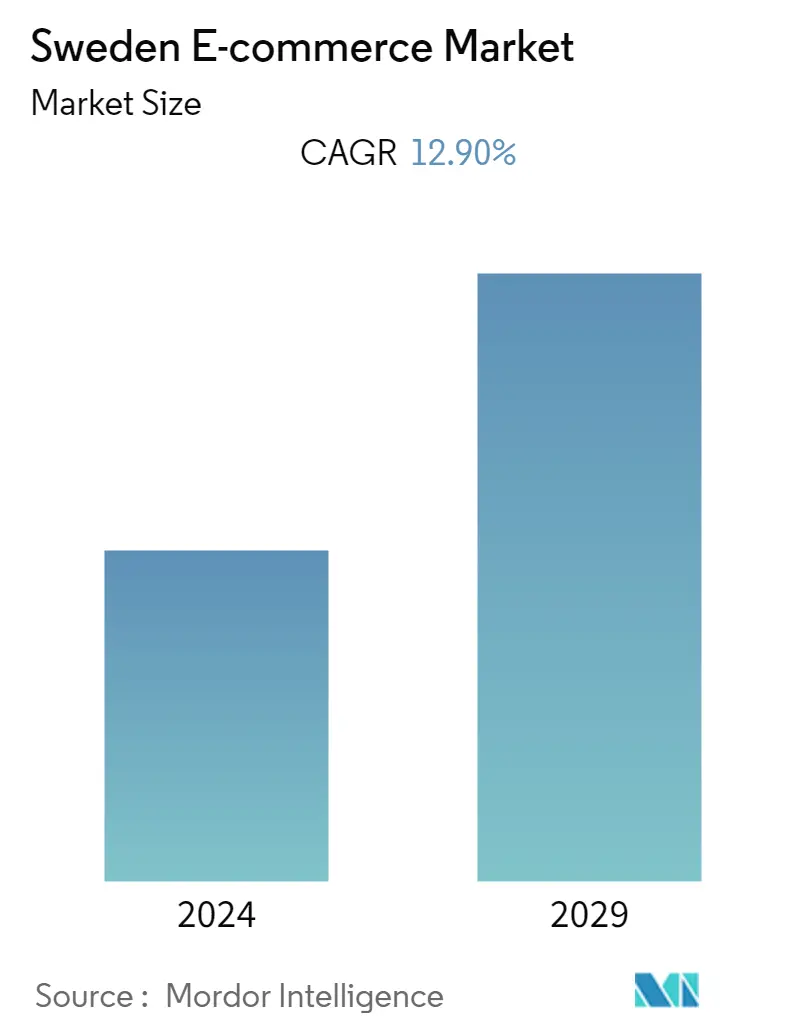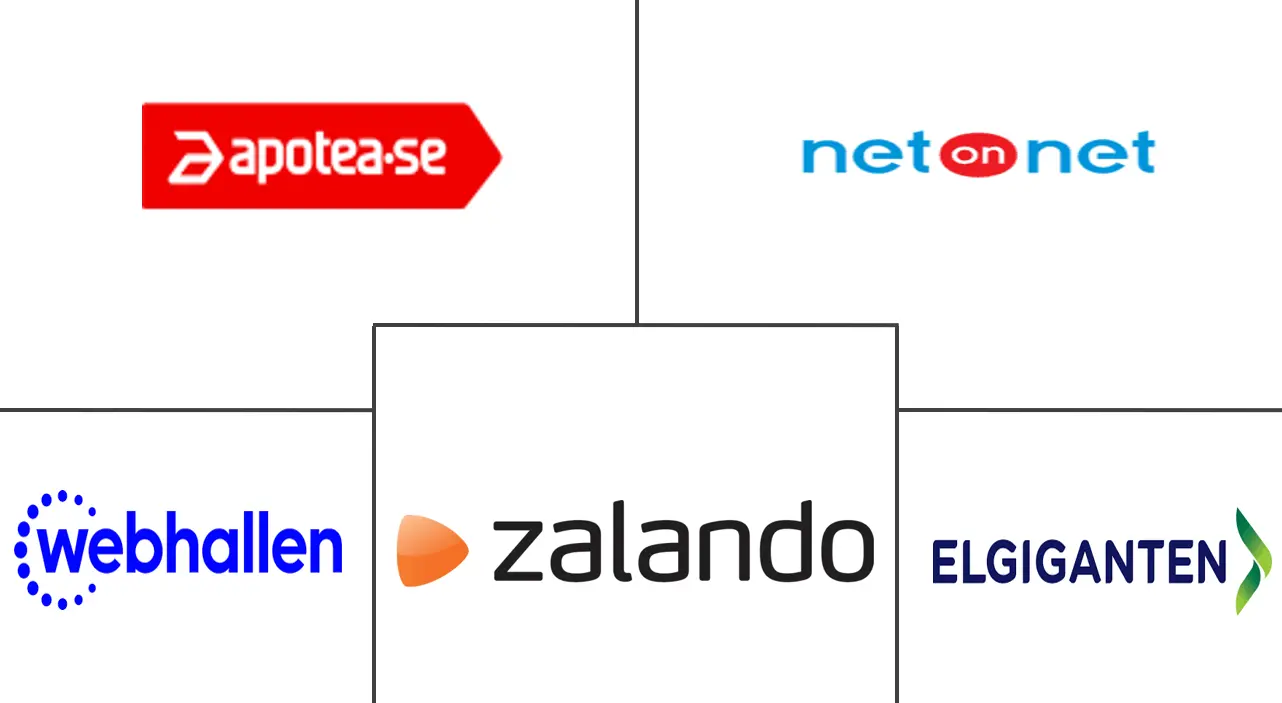Market Size of Sweden E-commerce Industry

| Study Period | 2019 - 2029 |
| Base Year For Estimation | 2023 |
| Forecast Data Period | 2024 - 2029 |
| Historical Data Period | 2019 - 2022 |
| CAGR | 12.90 % |
| Market Concentration | Medium |
Major Players
*Disclaimer: Major Players sorted in no particular order |
Sweden E-commerce Market Analysis
The Sweden e-commerce market is expected to register a CAGR of 12.9% during the period 2022-2027. The primary factor driving the growth of the market in the region is the strong economy and high internet penetration, among others.
- In terms of internet penetration, Sweden is one of the most advanced countries, and consumers have achieved a higher level of maturity when it comes to e-commerce. Consumers in the region are technology savvy and qualified spenders and at the top of e-Commerce usage in Europe and globally. Most Swedish online shoppers use their mobile and smartphones when researching websites, underscoring the importance of mobile solutions for webshops.
- Various factors are driving the growth of Sweden's e-commerce market. This includes the country's strong economy as well as changing consumer behavior, where more people now buy goods and services through online platforms. In addition, more and more services are now available online than ever before, which is also helping to fuel the growth of the e-commerce market.
- Home deliveries from companies that use Artificial Intelligence for route optimization have increased sharply in the region over the years. Many market players are looking for a Broad launch of parcel boxes that receive parcels from all logistics companies.
- Moreover, companies in the region are making essential reforms in the sustainability of e-commerce by creating eco-labeling for e-commerce deliveries and reducing the proportion of air in packaging. These factors are further expected to increase the growth of the e-commerce market in the region.
- Local e-commerce sales rules and regulations in the region can hamper the growth of the e-commerce market. For instance, United States e-commerce companies operating in Sweden need to comply with the European General Data Protection Regulation (GDPR). Moreover, VAT regulations can differ between digital and physical sales.
- During the COVID-19 outbreak, when physical stores were closed, the e-commerce market in the region grew owing to an increase in the strong demand for groceries, furniture, home furnishing, and pharmacy products, whereas there was moderate demand for the clothing and footwear segment. Moreover, the classic department store NK in Stockholm launched e-commerce. Many merchants have also started offering drive-through and click-and-collect.
Sweden E-commerce Industry Segmentation
Conducting an e-commerce business means fostering relationships and selling information, services, and goods over computer communication networks. E-commerce usually refers to trading goods and services over the internet, which means broader economic activity. E-commerce consists of B2B and B2C and internal organizational transactions that support these activities.
The study also tracks the key market parameters, underlying growth influencers, and major vendors operating in the industry, which supports the market estimations and growth rates over the forecast period in Sweden. The study further analyzes the overall impact of COVID-19 on the ecosystem. The scope of the report encompasses market sizing and forecast for segmentation by B2B and B2C, in which the B2C channel is further segmented by application.
| By B2C ecommerce | ||||||||
| Market Size (GMV) for the Period of 2017-2027 | ||||||||
|
| By B2B ecommerce | |
| Market Size for the Period of 2017-2027 |
Sweden E-commerce Market Size Summary
The Sweden e-commerce market is experiencing robust growth, driven by a strong economy and high internet penetration. Swedish consumers are highly tech-savvy and prefer mobile solutions for online shopping, which underscores the importance of mobile-optimized webshops. The market is further bolstered by changing consumer behaviors, with an increasing number of people purchasing goods and services online. The availability of more services online and the rise of home deliveries optimized by Artificial Intelligence are also contributing to market expansion. However, local regulations, such as compliance with the European General Data Protection Regulation and varying VAT regulations, pose challenges to market growth. The COVID-19 pandemic accelerated e-commerce adoption, with significant demand for groceries, home furnishings, and pharmacy products, while traditional retailers expanded their online presence.
The fashion segment holds the largest share of Sweden's e-commerce market, supported by benefits like free delivery, loyalty points, and discounts. The younger demographic, particularly those aged 16-44, is driving the demand for fashion products online. Sweden's commitment to sustainable fashion and events like Stockholm Fashion Week further encourage this trend. Digital marketing and social media advertising play crucial roles in influencing consumer purchases, with platforms like Facebook helping e-commerce players expand their market share. The market is moderately consolidated, with major players like NetonNET, Elgiganten, and Zalando SE leading the way. Innovations such as virtual stores and circular service offerings are also shaping the future of e-commerce in Sweden.
Sweden E-commerce Market Size - Table of Contents
-
1. MARKET INSIGHTS
-
1.1 Market Overview
-
1.2 Industry Attractiveness - Porter's Five Forces Analysis
-
1.2.1 Bargaining Power of Suppliers
-
1.2.2 Bargaining Power of Buyers/Consumers
-
1.2.3 Threat of New Entrants
-
1.2.4 Threat of Substitute Products
-
1.2.5 Intensity of Competitive Rivalry
-
-
1.3 Key Market Trends and Share of E-commerce of Total Retail Sector
-
1.4 Impact of COVID-19 on the E-commerce Sales
-
-
2. MARKET SEGMENTATION
-
2.1 By B2C ecommerce
-
2.1.1 Market Size (GMV) for the Period of 2017-2027
-
2.1.2 Market Segmentation - by Application
-
2.1.2.1 Beauty and Personal Care
-
2.1.2.2 Consumer Electronics
-
2.1.2.3 Fashion and Apparel
-
2.1.2.4 Food and Beverages
-
2.1.2.5 Furniture and Home
-
2.1.2.6 Others (Toys, DIY, Media, etc.)
-
-
-
2.2 By B2B ecommerce
-
2.2.1 Market Size for the Period of 2017-2027
-
-
Sweden E-commerce Market Size FAQs
What is the current Sweden E-commerce Market size?
The Sweden E-commerce Market is projected to register a CAGR of 12.90% during the forecast period (2024-2029)
Who are the key players in Sweden E-commerce Market?
NetonNet, Elgiganten, Webhallen Sverige AB, Zalando SE and Apotea AB are the major companies operating in the Sweden E-commerce Market.

